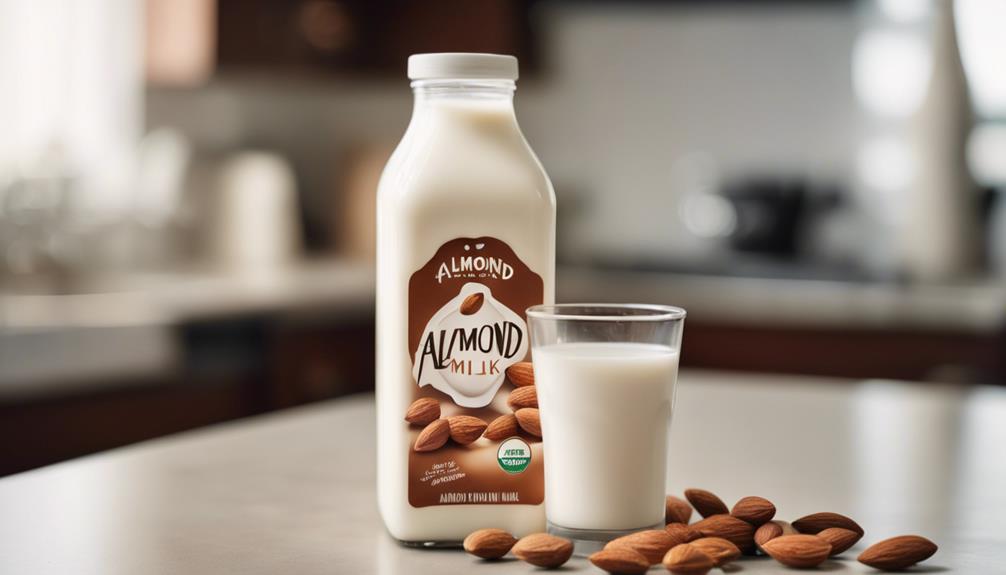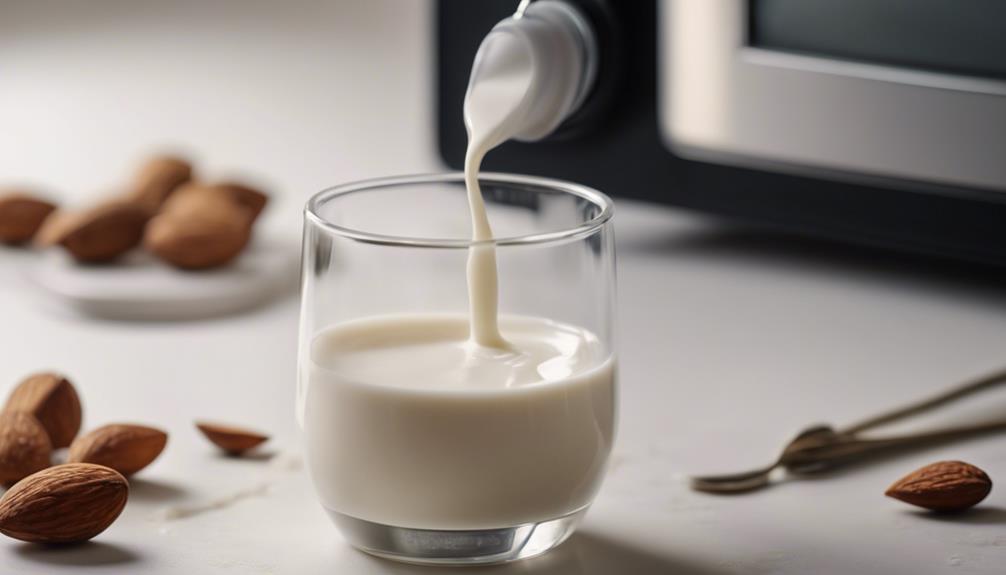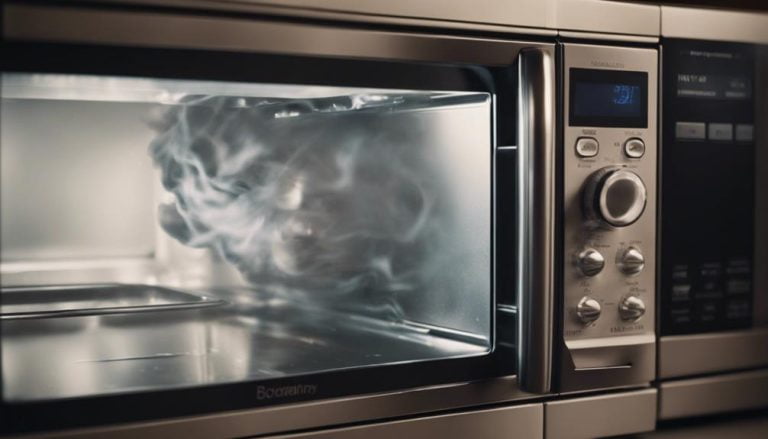Can You Microwave Almond Milk
Yes, you can microwave almond milk. Microwaving almond milk is a convenient way to warm it up for various uses. However, it is important to follow certain guidelines to ensure the best results.
When microwaving almond milk, it is important to heat it in short increments and stir it in between to prevent it from boiling or curdling. Overheating almond milk can cause it to separate or develop a burnt taste. Therefore, it is important to monitor the microwave closely and stop heating once the desired temperature is reached.
By following these guidelines, you can safely and effectively warm almond milk in the microwave without compromising its texture and flavor.
Key Takeaways
- Microwaving almond milk preserves nutrients and flavor effectively.
- Safety tips include using microwave-safe containers and avoiding overheating.
- Understanding labels ensures proper heating and nutritional value retention.
- Prevent curdling by gently heating, equalizing temperatures, and controlling mixing.
Benefits of Microwaving Almond Milk
Microwaving almond milk offers a convenient and efficient way to preserve its nutritional value while maintaining its delicate flavor and texture. Heating almond milk in a microwave-safe container helps retain essential nutrients such as vitamin E, calcium, and healthy fats.
By utilizing low power settings, almond milk can be heated without boiling or curdling, resulting in a smooth consistency that enhances its taste. This method is not only quick, taking only a minute or two, but also ensures that the almond milk's nutritional benefits remain intact.
Whether adding it to coffee, tea, or hot chocolate, microwaving almond milk provides a hassle-free way to enjoy its goodness without compromising on quality.
How to Safely Microwave Almond Milk
When microwaving almond milk, it is crucial to prioritize safety measures to avoid any mishaps. Following simple guidelines like using a microwave-safe container and heating in short intervals can help maintain the almond milk's quality.
Microwave Almond Milk
To safely heat almond milk in a microwave, it is essential to ensure the container used is microwave-safe and to follow recommended heating guidelines to preserve its quality and taste. When microwaving almond milk, choose a microwave-safe container and heat it in short bursts at a low power setting to prevent overheating.
Stir the almond milk every 30 seconds during the heating process to ensure even distribution of heat and prevent curdling. It is important to avoid boiling almond milk, as this can impact its taste and nutritional value negatively.
Safety Tips for Microwaving
In ensuring the safe and effective microwaving of almond milk, the choice of a suitable, microwave-safe container is paramount for maintaining quality and taste. It is recommended to use containers made of glass or ceramic to heat almond milk safely.
When microwaving almond milk, it is advisable to heat it in short 15-second intervals to prevent scalding or boiling over. Stirring the almond milk thoroughly after each interval promotes even heating and helps to avoid hot spots. Overheating should be avoided to preserve the taste, texture, and nutritional value of the almond milk.
Additionally, when mixing almond milk with coffee, selecting low-acid coffee can reduce the likelihood of curdling during the heating process.
Understanding Almond Milk Labels

When considering almond milk labels, it is essential to focus on reading for microwave safety instructions, nutritional breakdown, and ingredient transparency. These aspects provide valuable information on the suitability of almond milk for microwaving, its contents, and any potential allergens.
Understanding the labels ensures a safe and informed decision when using almond milk in the microwave.
Reading Almond Milk Labels
Check almond milk labels for specific microwave heating instructions to ensure safe and proper usage of the product. When examining almond milk labels, look for indications of microwave safety provided by the manufacturer. Some almond milk brands may offer detailed guidelines on how to heat their product in the microwave.
If there is any uncertainty regarding microwave safety, it is recommended to contact the manufacturer directly or visit their website for more information. Understanding almond milk labels can play a crucial role in determining whether it is safe to microwave the product.
Nutritional Information Breakdown
Within almond milk labels, detailed information on calories, fat content, protein, sugar, and added vitamins and minerals is typically provided for consumers to make informed dietary choices.
- Look for labels indicating if almond milk is unsweetened, original, vanilla, or flavored for nutritional differences.
- Check for fortification with calcium and Vitamin D to ensure proper bone health support.
- Labels may specify if almond milk is organic, non-GMO, or free from additives like carrageenan or artificial flavors.
- Understanding almond milk labels helps consumers make informed choices based on individual dietary needs and preferences.
- Pay attention to the nutritional benefits of almond milk, such as being a plant-based milk option rich in vitamins and minerals.
Ingredient Transparency
Almond milk labels provide essential information regarding the ingredients used in the product, offering transparency to consumers seeking to understand the composition of the beverage.
When considering heating almond milk, it is crucial to check for microwave safety information on the packaging. Look for specific heating instructions provided by the almond milk company to ensure the proper heating method. Contacting the almond milk manufacturer for detailed microwave safety guidelines can also be beneficial.
Before heating almond milk in the microwave, verify if the container is microwave-safe. Maintaining transparency is key, so reviewing almond milk labels for accurate heating instructions is imperative to ensure the safe consumption of this popular dairy alternative.
Preventing Almond Milk Curdling

To prevent curdling of almond milk, ensuring the temperature of the milk is raised to at least 104 degrees Fahrenheit is essential. When heated in the microwave, using gentle heat can prevent the milk from curdling or separating. Here are some tips to help prevent almond milk curdling:
- Equalize temperatures of coffee and almond milk before mixing to avoid curdling.
- Gradually mix coffee with almond milk to prevent curdling and separation.
- Choosing low-acid coffee or cold brew can reduce curdling when mixed with almond milk.
- Proper temperature control and gradual mixing can help prevent curdling of almond milk when heated or combined with other ingredients.
Quick Tips for Microwaving Almond Milk
What are some efficient methods for microwaving almond milk while preserving its texture and flavor?
When heating almond milk in the microwave, it is essential to use a microwave-safe container to ensure safety. To prevent curdling, heat the almond milk in short bursts at a low power setting. Stir the almond milk every 30 seconds to ensure even heating throughout. Avoid boiling the almond milk as this can alter its taste and nutrient content. Stop microwaving the almond milk as soon as steam appears to prevent it from boiling over.
Ideal Microwave Settings for Almond Milk

When considering the ideal microwave settings for heating almond milk, it is crucial to prioritize maintaining the integrity of its texture and flavor profile. To achieve this, follow these guidelines:
- Set the microwave power to 50% to prevent boiling over.
- Heat almond milk in short 30-second intervals to reach the desired temperature gradually.
- Stir the almond milk thoroughly between heating intervals for even heat distribution.
- Use a microwave-safe container to ensure safety and prevent chemical leaching.
- Stop heating when steam appears to avoid boiling and preserve the taste and nutrients of the almond milk.
Reheating Almond Milk in the Microwave
For convenient reheating of almond milk, using a microwave-safe container in short intervals is recommended to preserve its quality and prevent overheating.
To ensure even heating and prevent boiling over, stir the almond milk between intervals. It's crucial to stop microwaving once steam appears to avoid overheating, which can affect the taste and texture of the almond milk.
Reheating almond milk in the microwave offers a quick and easy way to enjoy warm beverages or incorporate it into recipes without compromising its quality.
Serving Suggestions for Microwaved Almond Milk

To complement the versatility of reheated almond milk, exploring various serving suggestions can elevate the experience of incorporating this creamy and flavorful dairy-free alternative into your favorite hot beverages and recipes.
- Use microwaved almond milk in beverages like lattes, hot chocolate, and matcha lattes.
- Enhance the taste of golden milk, a popular turmeric-based beverage, with microwaved almond milk.
- Add a creamy texture and nutty flavor to hot drinks by heating almond milk in the microwave.
- Serve microwaved almond milk as a dairy-free alternative in various hot beverages and recipes.
- Enjoy the convenience of quickly warming almond milk in the microwave for a cozy drink experience.
Frequently Asked Questions
Can I Microwave Almond Milk Straight From the Carton or Should I Pour It Into Another Container First?
Heating almond milk straight from the carton is acceptable if the packaging indicates microwave-safety; otherwise, transferring it to a microwave-safe container is recommended for better temperature control. Following proper heating instructions ensures microwave safety and preserves nutritional value and shelf life.
Is It Safe to Microwave Almond Milk in a Plastic Container or Should I Use a Glass One?
For optimal microwave safety, using a glass container over plastic is paramount when heating almond milk. Glass prevents chemical leaching and maintains purity. Safeguard taste, nutritional value, and avoid potential health risks by choosing glass for microwaving almond milk.
Can I Add Sweeteners or Flavorings to Almond Milk Before Microwaving It?
Yes, you can enhance almond milk by adding sweeteners like honey and flavorings such as vanilla extract, cinnamon, nutmeg, or other spices before microwaving. Experiment with different combinations like stevia, agave, coconut, or chocolate for a customized beverage.
How Long Can I Store Microwaved Almond Milk in the Refrigerator?
Almond milk freshness is maintained when stored in the refrigerator for up to 4 days after microwaving. Proper sealing in an airtight container is crucial. Check for spoilage signs before consumption. Consume within the recommended timeframe for optimal taste and nutritional value.
Can I Use Almond Milk That Has Been Microwaved in Recipes That Call for Regular Milk?
Almond milk consistency, flavors, and benefits are retained when microwaved. It can be used as an alternative in recipes requiring regular milk, especially when milk isn't the primary flavor. Experiment to find the best applications for your preferences.
Conclusion
In conclusion, microwaving almond milk can be a convenient and safe way to warm this popular dairy-free alternative.
By following proper guidelines and precautions, such as using a microwave-safe container and heating in short intervals with stirring, you can enjoy a delicious and nutritious cup of warmed almond milk.
Just like a warm hug on a chilly day, microwaved almond milk can provide comfort and satisfaction in every sip.






